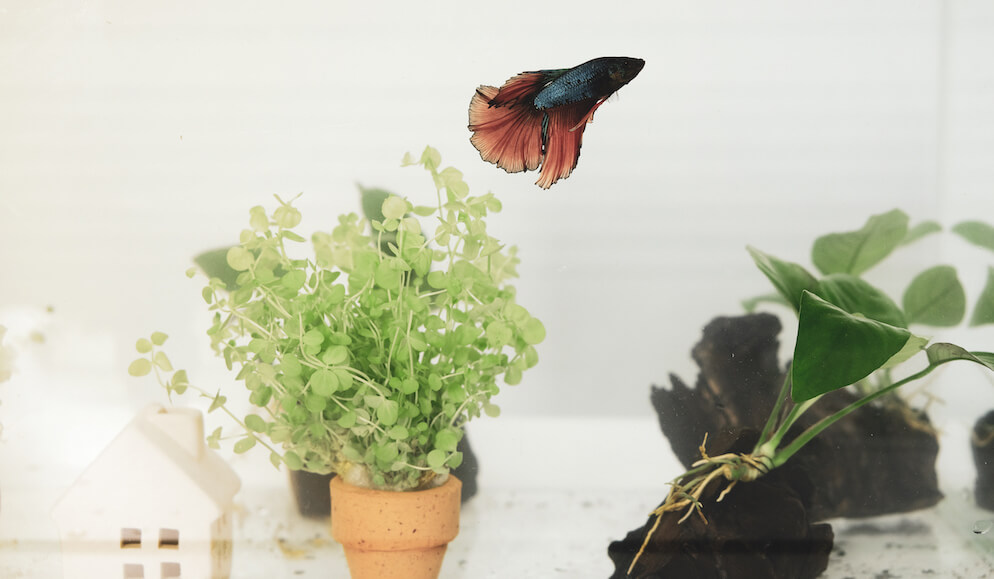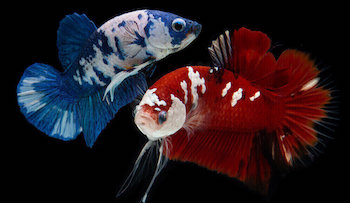
As we have discussed in the previous article on “How To Care For Betta Fish”, betta fish, or better known as ‘Siamese Fighting Fish’, are known for their aggressive streaks in contrast with their vibrant colored fins and scales.
Special instructions on the care are catered to these fishes, especially if a fish keeper, beginning hobbyist, or enthusiast would want to care for bettas. Picking the tankmates carefully to suit your betta fish is one of the significant issues and challenges in creating a harmonious tank with this beauty as the main attraction.
Betta fish have a long history of selective breeding. It is the due cause of some Asian countries such as Thailand and Indonesia making use of these fishes in illegal fighting gambles, resulting in the name: Siamese Fighting Fish. Since the 19th century, locals have observed the personality and characteristics of the betta fish. It garnered widespread attention and news in the realm of gambling. Therefore, it started the centuries-long selective breeding in producing more colorful fish and increasing its aggressiveness, which still thrives among wild bettas and even those who bred in captivity.
Though betta fish personality varies per breed whereas some still easily provoked by both of its kind and other fish. Betta fish has also become more territorial, and when this trait directed towards those who are too meek, other fishes can easily be stressed out by this tankmate and even bullied by it.
What bettas need at the first instance of keeping one is the tank space. Most fighting or quarrels among betta fish and their fish counterparts results from the lack of tank or swimming space. Betta fish in captivity, according to research, are more territorial and aggressive than those in the wild, and this is because of the larger and more open swimming space and abundance of hiding places such as rocks and plants. Since betta fish are territorial, this is not just because of their breeding but the necessity of surviving. They continuously protected their territories for reasons of mating, breeding, and food.
Having other betta fish around, especially for males, increases their anxiety of taking over their territory and, therefore, increases the chances of fighting. The result of this fighting depends on the length of time. It can either be missing scales, nipped fins to more severe injuries, and even death.
Oddly enough, as betta fish are hostile against their kind, especially the males, they do better with other fishes. It is better to keep only one betta fish in a community tank, but betta fish are peaceful species with careful prompting. They can live with other animals too–such as frogs, shrimps, and snails without any hassle for different styles in habitats.
The general rule in choosing tankmates for bettas is one, don’t pick fish with long tails, and second, don’t pick fish with vibrant colors.
Is It Essential for Betta Fish to Have Tankmates?
In pet stores, betta fish is suitable to house in a single tank alone because of their temperament as what their name suggests, Siamese FIGHTING fish. But having one betta fish in a tank looks dreary, so many fish owners add tankmates to make fish happier.
But in the case of the betta fish, this may backfire due to its temperament. Before adopting any kind of fish, do some research and invest in a sizeable tank that will let you take care of this type of fish better and add a couple of fish here and there.
Betta Fish Among Their Own

As mentioned before, betta fish have aggressive streaks and especially so towards their own. Males are preferred over female bettas since they have a more iridescent coat and are a great deal more aggressive towards other male bettas and even females.
Betta fish can be quite territorial, so having another male in the tank brings up the competition of fighting over territory, food, attracting females, and breeding ground. Males are also hostile toward females and would most likely end in a fight.
A quarrel between betta fishes can be quite gruesome, often resulting in injury besides the nicked scales and fins, and sadly, and even death of the other during the fight or because of the damage it attained. It is the sole reason why it is advised for all fish keepers, especially for newbie hobbyists to keep only one betta fish in one aquarium.
Betta fish target gills, tails and scales and will most likely counterattack when bitten by known fin biters such as the red tail shark or angelfish. You should avoid mixing them in with their relatives such as the Gourami. Also, avoid vibrant fish such as goldfish, and other types of fish that are bigger and with the same fin are your betta.
In community tanks, try to build up to a serene and harmonious environment for your fishes with the betta fish.
Tank Size
Tank size is one of the most important aspects of keeping betta fish and building their rapport with other fish companions.
The minimum requirement for keeping your betta fish is 5 gallons, and you can build up from that size that will also depend on the rate by which your fishes are growing. As fish grows, you’d have to transfer them to a bigger tank because the lack of swimming space stresses them. Some fishes need more than 5 gallons, so also keep in mind the type of fish. A rule of thumb is that the length of fish by inch requires a gallon of water.
Of course, with the increase in the amount of fish, their bioload also increases or the waste they produce alongside excess food they didn’t eat. Bioload is toxic to fish since it becomes contaminants or pollutants wherein ammonia will build up in your tank affecting your tank’s pH level making the water poisonous for the fish and, as a result, making them sick.
Invest in a decent water filter that ensures and keeps your tank’s pH level and maintenance intact. It will lessen the need to clean up your tank. It will cut your workload, worry, and stress over maintaining the tank as it will keep up with your fish.
Probable Tankmates
Here is a list of prospective candidates running for fish companions suited to your betta. But alongside their tolerance for betta fishes are their specific preferences and requirements in the tank, better-paying attention to their kirks as you create a paradise of your own.
1) Corydora Catfish
Better known as Cory Cats, these live in the same water conditions as betta fish. They are hardy and peaceful at the same time, making them quite easy to take care of. They are bottom feeders who much prefer to roam at the bottom of your tank. They are versatile and can add as an individual fish in your tank or with even more.
These can consider a fashionable addition to tanks since they come in so many colors and varieties, giving the owner freedom for a partner it with the tank’s theme, design, or color scheme of other fish. They can grow only up to 2 1/2 inches and can live 2-3 years in the tank.
They are peaceful fish and are quite active in the tank, but be careful in choosing your cory cat’s color since you don’t want them to draw attention from your betta.
2) Clown Plecos
These are quite small under the dwarf pleco species and can grow for only up to 4 inches. Amazingly, because of their size, they can thrive in only two feet of water. These are specifically suited for betta fish.
Do not be confused with the common pleco since these grow up to 2 feet long!
It swims in the same water conditions as the cory cats and betta, so there would not be drastic changes. They are hardy, peaceful fish that feeds on algae. Despite their size, they can enjoy a good 10-12 years in the tank. They are relatively easy to take care of, and even if they manage to catch a betta’s attention, they have tough skin.
3) Kuhli Loach
Although they have elongated bodies like eels, kuhli loach is quite peaceful and can get along well with any fish. They can grow up to 4 inches in the tank, though they need 20 gallons of water for swimming space. In terms of tank design, they prefer to burrow on sand or smooth gravel substrates to dig themselves in. Careful not to put any rocks since they can get injured and scratch their underside with rocks and other sharp edges from objects.
If you’re thinking of buying one, they will thrive in numbers, so buying three or more would be advisable.
They also enjoy a great long life up to 10 years, of course, depends on how they are well taken care of.
4) Neon Tetras
Based on their names, neon tetras exhibit attractive colors that will catch the attention of bettas. Luckily, the spunky neon tetra is a fast swimmer and can outswim bettas at every chance. In addition to this, they are low maintenance.
Neon tetras typically grow to 4 centimeters and live up to 5 years in captivity despite their small size. In numbers, they can be quite a menace to other fishes since they tend to nip fins. Having a big enough tank is needed in taking care of this particular fish. It is recommendable for this type is 20 gallons in a long, narrow tank that will provide plenty of swimming space and territory for horizontal swimmers like this fish.
If you’re building a community tank, having more than one will keep this fish type happy, dropping 6 to 10 neon tetras in the tank would be sufficient.
In terms of tank design, Neon tetras like having a lot of plants around for hiding, which would be beneficial even for the bettas.
5) Harlequin Rasbora
In the wild, harlequin rasbora coexists with the Siamese Betta Fish. They are known to get along well with betta fish and other types since they are quite docile and will give any tank a nice touch of color. They are also quick swimmers and can quickly get away from a betta fish.
They are schooling fish, so putting in 5 to 6 of this in the tank is needed. Besides, you’ll also need a 20-gallon tank to hold this fish since it can grow up to 2 inches.
Just like bettas, harlequin rasboras like to snack on brine shrimp. They enjoy 5 to 8 years of lifespan in a harmonious tank.
In taking care of betta fish, you should avoid the following:
- Keeping two betta fish in the tank, especially if they are two male ones.
- Having iridescent and fish with long tails and fins.
- Gouramis. These are their cousins and share the same temperament.
Conclusion
We have given some of the best choices as tankmates for the Siamese Fighting Fish, which would give you an idea of making a community tank, or only, keeping your lone betta in a tank. But this doesn’t guarantee what your betta would feel, so monitoring is the must by observing your betta fish’s reaction to the new fish.
Betta fish temperament and aggressiveness will show in just a few days, and these may be the signs:
- visible wounds (nipped fins and scales);
- lack of appetite;
- nonstop chases;
- and quarrels that last a considerable duration.
Your community tank with a betta in it indeed revolves around this particular fish and making it success also depends on your betta’s character and temperament. The fish listed above has the most excellent affinity to achieve a harmonious aquarium.








